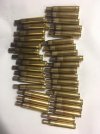I was really worried about annealing correctly and after watching a couple of YouTube videos by Erik cortina (some pro shooter) I feel like the most important thing is to be consistent and don't go so far you start to anneal too far down the case.
In one of his videos, he shows he he usually does it and he leaves the flame on longer than what I've seen a lot of people on here recommend.
Do the same thing every time and don't go too far.
In one of his videos, he shows he he usually does it and he leaves the flame on longer than what I've seen a lot of people on here recommend.
Do the same thing every time and don't go too far.

